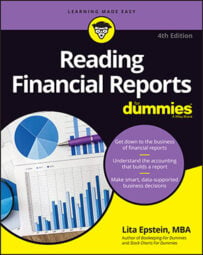The eliminations to adjust for reporting subsidiary results don't show up in the parent company's financial reports unless some portion of the stock acquisition takes place in the year that's being reported. When the acquisition or some financial impact of that acquisition does take place in the year that's being reported, you need to look to the notes to the financial statements to get details about any financial impacts.
In the first note to the consolidated financial statement, the company indicates that the financial statements represent the results of the parent company, not its affiliates. The company also includes some statement about the eliminated transactions. Just to give you an example of how this is worded, here's the information from GE's notes.
Here, verbatim, is how GE explains its presentation of the number in its financial statements:
Financial data and related measurements are presented in the following categories:
GE: This represents the adding together of all affiliates other than General Electric Capital Corporation (GECC), whose continuing operations are presented on a one-line basis, giving effect to the elimination of transactions among such affiliates.
GECC: This represents the adding together of all affiliates of GECC, giving effect to the elimination of transactions among such affiliates.
Consolidated: This represents the adding together of GE and GECC, giving effect to the elimination of transactions between GE and GECC.
Operating Segments: These comprise our eight businesses, focused on the broad markets they serve: Power & Water, Oil & Gas, Energy Management, Aviation, Healthcare, Transportation, Home & Business Solutions and GE Capital.
Prior-period information has been reclassified to be consistent with how we managed our businesses in 2012.
Note that you don't find out what subsidiaries fall under GE in this explanation. Few companies provide that detail. Sound like a confusing house of cards? Yep, it sure is, which is what makes reading consolidated financial statements so difficult!
Mergers and acquisitions
If a company completes a merger or acquisition in the year that's reported on the consolidated financial statement, you find a special note in the notes to the financial statements. Otherwise, if you want to find out any details about how the mergers and acquisitions may still be impacting the company financially, you have to start digging.
For example, if a company issues additional shares of stock to buy a subsidiary, the value of the stock held by shareholders before the acquisition is diluted, which means that the same earnings or assets must be divided among a greater number of pieces. To see how this works, imagine an example involving 100 shares of stock and a company profit of $100.
In this scenario, each share of stock claims $1 of earnings. If, after the acquisition, 150 shares of stock are outstanding, each share of stock can claim only 67 cents of the $100 of earnings. This diluted ownership impacts the amount of dividends or the portion of ownership you have in the company for the rest of the time you own that stock.
Companies don't make information easily accessible, and they often hide the financial impact of an acquisition or merger on the value of your shares by writing the notes to the financial statements in such a convoluted way that you have to be a detective to sort out the relevant details.
Goodwill
Another important note you can check out to find the impact of mergers and acquisitions on the consolidated financial statements is the note that explains goodwill. Goodwill is the amount of money a company pays in excess of the value of the assets when it buys another company.
For example, suppose a company has $100 million in assets, and another company offers to buy it for $150 million. The extra $50 million doesn't represent tangible assets like inventory or property; it represents extra value because of customer loyalty, store locations, or other factors that add value. Goodwill is a factor only in the case of a merger or acquisition that involves acquiring 100 percent of the affiliate.
Liquidations or discontinued operations
Whenever a company sells a subsidiary or other affiliate or discontinues its operations, a note to the financial statements regarding this transaction appears in the year in which the transaction first occurred. After the first year, any impact that a sale or a discontinuance of operations has on a company's operating results is usually buried in other notes.
Just like with mergers and acquisitions, you have to play detective to find out any ongoing impact that these changes have had on the company.
The company includes information in the notes about any profits or losses related to the liquidation of an asset or discontinued operations. Because these transactions can impact financial statements over a number of years, the fine print includes financial impacts for the years prior to the year being reported, as well as anticipated future impacts.
When reading the consolidated financial statements and their related notes, be sure you look for any mention of the impact of previous mergers or acquisitions of affiliates and how those transactions may still be impacting the financial statements.
You may find notes related to impacts on the balance sheet, income statement, shareholders’ equity, or cash flows. Transactions involving affiliates can impact any of these statements.

